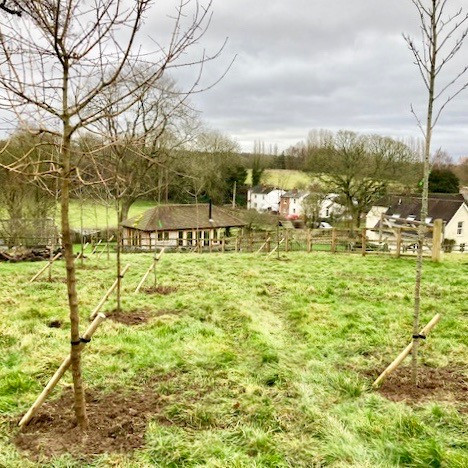Hampshire Garden Design & Maintenance Consultancy Est. 2000
CallArboriculture
While we’re not arboriculture specialists per se we do provide some fairly specialist tree care services. For example:
Tree maintenance: The circled trees show a technique we’ve had great success with, as it allowed us to reinvigorate some very old/ tired trees. It involved cutting a trench 10 to 12 inches down in a circle around the tree and lining it with really good compost and in this case Poultry manure. This allows the nutrients to be reached quickly and easily by the fibrous roots of the main root ball. It’s also a great way to increase oxygen flow to the roots. It really breathed fresh life into ageing trees which had lost their lustre.
Pruning is a huge part of the work that we do and it’s actually more complex than it at first appears. The snowy photos show apple tree pruning which if done right; keeps them healthy and fruiting well; maintaining their size so they stay manageable and the fruit remains accessible without the need for cherrypickers / unnecessary time and effort. Overgrown trees can split and are more prone to storm damage. Correct pruning can protect the longevity and health of the tree as well as the obvious aesthetic benefits.
Additionally you can see more apple trees pictured in rows of espalier. Espalier is the horticultural practice of controlling plant growth for the production of fruit, by pruning and tying branches to a frame. We often use espalier in smaller spaces to provide fruit in a more space efficient way. But they look just as attractive and work equally well in larger gardens too.
Another example of tree care can be seen in the tree renovation project, above the yew hedge. These trees were massively overgrown and had been allowed to completely outgrow their space. Becoming increasingly difficult to hedge cut, something needed to be done.
Pleaching was common in gardens from late medieval times to the early eighteenth century, to create shaded paths, or to create a living fence out of trees or shrubs. Used here it allowed us to add interest, structure and create shade for the walkways. The original pleaching was a year ago so the after photos show a year's worth of growth. Once they’ve regrown to fill in and form a tighter screen, we will re-pleach in 3 to 5 years time. The choice of tree when pleaching is critical - here these are Lime (tillia) trees which are one of the best suited to the technique. Hornbeam is another excellent choice for pleaching.
Tree planting is done for various reasons: aesthetic, environmental benefits, shade, nitrogen locking benefits for soil, improving drainage and managing soil moisture, the list goes on… We always suggest native varieties as they support our local ecosystems in the best most natural way possible. Pictured you can see an empty paddock which we planted to screen from the neighbouring industrial unit and to add a little interest at the same time as extending an existing orchard. All native varieties; Field maple, acer campestre, amelanchier lamarckii, cherries (prunus avium) apples and plums and wild service tree - Sorbus torminalis and aucuparia.
It’s really important to cultivate the ground and stake properly considering the prevailing wind direction. The addition of rabbit and deer guards are also essential in some areas. It’s also best practice to keep a good space around them which can really speed growth and facilitate the establishing roots.





































